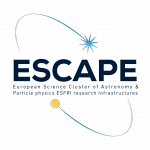 ESCAPE: European Science Cluster of Astronomy & Particle physics ESFRI research infrastructures has received funding from the European Commission Framework Programme Horizon 2020 Research and Innovation action under grant agreement n. 84064.
ESCAPE: European Science Cluster of Astronomy & Particle physics ESFRI research infrastructures has received funding from the European Commission Framework Programme Horizon 2020 Research and Innovation action under grant agreement n. 84064.
H2020-ESCAPE aims to address the Open Science challenges shared by ESFRI facilities (CTA, ELT, EST, FAIR, HL-LHC, KM3NeT, SKA) as well as other pan-European research infrastructures (CERN, ESO, JIV-ERIC, EGO-Virgo) in astronomy and particle physics research domains. The official project launch date is 1 February 2019. The project has a runtime of 42 months and it will be coordinated by CNRS-LAPP, Annecy.
The complexity of all this new apparatus in science grows rapidly, the data volume produced by them is seeing a tremendous increase and the software to analyse the data is becoming more and more complex. On the other hand, this data should be accessible to the growing scientific communities, as they collaborate and interact. The ESCAPE project brings together partners from astronomy and particle physics to collaborate on building the EOSC. The ESCAPE actions aim at delivering solutions to ensure integration of data, tools, services and scientific software; to foster common approaches to implement open-data stewardship; to establish interoperability within EOSC as an integrated multi-probe facility for fundamental science.
UNITOV within the ESCAPE project:
UNITOV and CWI will design and implement Machine Learning algorithms, based on Neural Network, leveraging state-of-the-art open libraries for the prediction of solar wind conditions (speed and magnetic field) at L1, the estimate of arrival time of CMEs and the prediction of flare class, combining different sources of data (e.g.: SOHO, SDO, Proba-2, ground-based observatories) and have the algorithms ready to ingest future EST data.
The utlimate goal is to improve our understanding of solar physics phenomena, space weather prediction capability, and to better exploit the big data available to the solar physics community.



